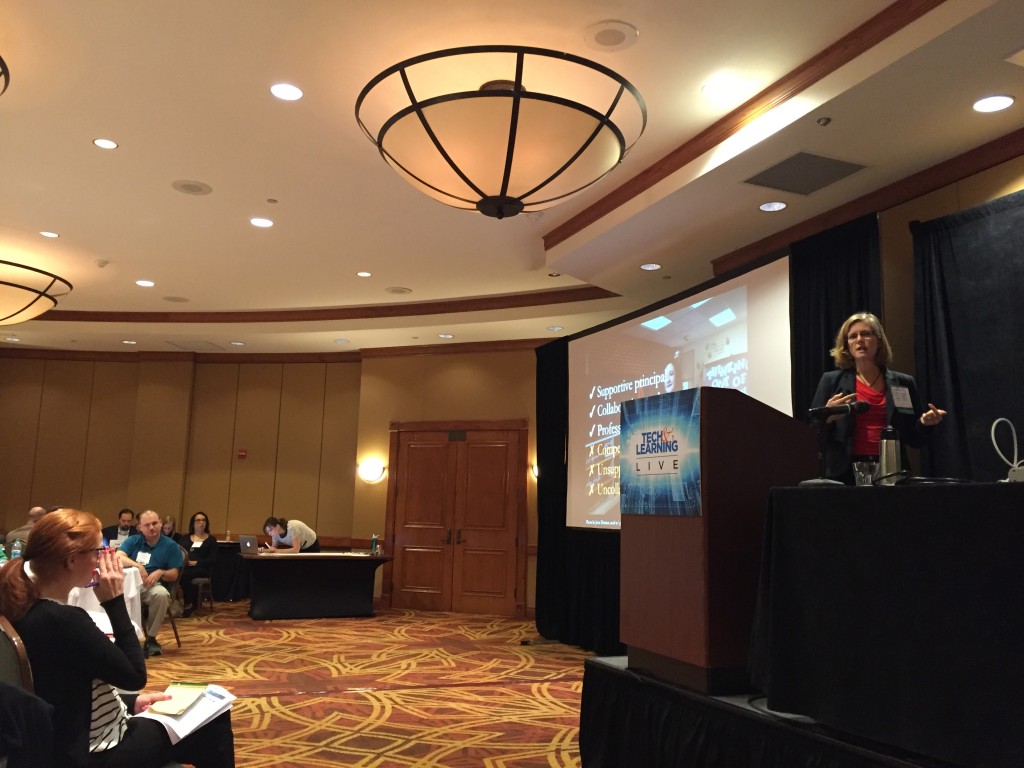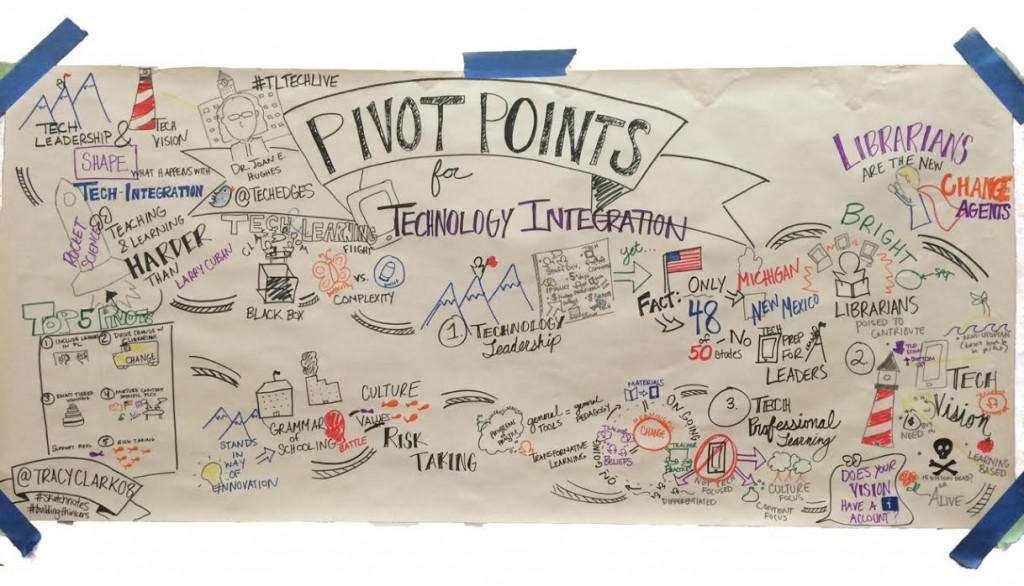5 Pivot Points for Technology Integration
 Yesterday, I keynoted the Tech & Learning Live Austin event. The day was spent considering professional learning and technology integration. In my morning keynote, I shared classroom and school-based research insights on technology integration. Specifically, I talked about how technology leadership, technology vision, and professional learning shape successful technology integration efforts in K-12 schools. The talented Tracy Clark @tracyclark08 sketched the content, which is also included below.
Yesterday, I keynoted the Tech & Learning Live Austin event. The day was spent considering professional learning and technology integration. In my morning keynote, I shared classroom and school-based research insights on technology integration. Specifically, I talked about how technology leadership, technology vision, and professional learning shape successful technology integration efforts in K-12 schools. The talented Tracy Clark @tracyclark08 sketched the content, which is also included below.
I ended the keynote with 5 research-based actions schools can do to pivot towards successful technology integration. They include:
#1: If school leaders must tend to their own technology learning*, we should be inviting them to the professional learning opportunities we arrange in schools and districts. And leaders – you should go! I’ve created opportunities for leaders to engage with actual technology-supported lessons for K-12 learning, and they loved this so much. *Research shows that only 2/50 states require technology preparation course for school leadership degrees, and examination of school leadership curricula reveals 92% of 137 programs do not mention technological courses or preparation. Of the 7%, the technology relates to data-driven decision making, not teaching and learning with technology.
#2: Librarians are the new technology integration change agent*! Use this to your advantage. Hire and cultivate technology-interested librarians and encourage their contributions to your leadership team. *Research shows that librarians contribute to technology leadership activities because of their knowledge of pedagogy, curriculum, technology, and collaboration. Enablers of librarians to do this work include (a) supportive principal, (b) collaborative teachers, and (c) engagement with professional organizations. A disabler is a competitive instructional technologies.
#3: While an optimal technology vision has had input from constituents, not everyone participates in that process*. To increase awareness and buy-in for your technology vision, enact tiered visioning through small groups or PLCs, grade level teams, subject area teams) who develop their own mini technology vision. Think of these mini-visions as a wedding cake – the largest cake bases are built from these small group mini-visions and support and relate to the overarching school or district vision (the top tier). This can enable top-down and bottom-up visioning and enactment at the classroom level. *Research shows more success with technology integration if the technology vision is learner-focused, curricular-focused, and pre-planned in collaboration with stakeholders, such as leaders, technology directors, librarians, teachers, parents, and students. They can emerge from top-down or bottom-up processes as long as the visions are communicated widely and garner buy-in among stakeholders.
#4: Nurture content-specific, ongoing professional learning, such as in professional learning communities (PLCs) that examine problems of practice (POPs)*. If these PLCs have created mini visions (see Pivot #3 above), it’s a logical next step to work on enactment (with support). *To have meaningful, transformative technology integration, research shows the materials (e.g., technologies) must change but that is not sufficient. You must also change teacher beliefs and teacher practices.
#5: If we are asking teachers to change their practices and beliefs, then we must support real risk-taking by working towards cultural change*. *Changing our beliefs and practices will challenge the “grammar of schooling,” which is a school’s engrained educational format and goals. Thus, the kind of change you are working towards will necessitate changes in school culture. School leaders who are successful in technology integration create value and appreciation and support for risk-taking, exploration, and innovation.
This presentation is licensed under a Creative Commons Attribution-NonCommercial-ShareAlike 4.0 International License. Please feel free to share with others, with attribution.
The content of what I spoke about is in the NOTES of the presentation.
 Sketch by Tracy Clark
Sketch by Tracy Clark
AERA 2014 Presentations
Join us for our paper presentations at this year’s American Educational Research Conference in Philadelphia, PA.
Paper 1
Presenters: Joan E. Hughes, Michelle F. Read @MiShe11e, Sara J. Jones @sara_jones
Title of Paper: A Predictive Profile of Youths’ Web 2.0 Outside-School Activities
Day, Time, Location of Presentation: Saturday, April 5, 2:45-4:15 PM, Convention Center, Terrace Level, Terrace IV
Abstract: This quantitative study used multiple regression to identify predictors of middle school students’ Web 2.0 activities out of school, a composite variable constructed from 15 technology activities. Three middle schools participated in the study and 6th and 7th grade students completed an online survey. Independent predictor variables included school, gender, ethnicity, grade level, computer limits at home, assigned computer-based homework at school, total gadgets at home, Web 2.0 activities in school, traditional technology activities in school and three interaction variables. Results reveal a model explaining 25% of the variance, with statistically significant predictors including: school, ethnicity, grade, total gadgets, and the interaction of school and in-school Web 2.0 activities. Knowing what students do outside of school, and how in-school and out-of-school variables may impact such activity may assist educators in planning for technology in instruction and learning that both leverage what students are already doing or may wish they were doing, making learning motivating and connected to real life.
Paper 2
Presenters: Joan E. Hughes, Audrey De Zeeuw, Min Wook Ok
Title of Paper: Leadership and Vision in a High School 1:1 iPad Innovation in Practice
Day Time, Location of Presentation: Monday, April 7; 8:15-9:45 AM; Convention Center, Terrace Level, Terrace IV
Abstract: This research examines the school and district leadership practices, including setting direction, developing people, and making the organization work, in the first year of a 1:1 iPad innovation in practice at Hilly High School (HHS) in the southwestern United States. Participants included 6 district and 4 high school leaders. The study employed descriptive case study methodology with ethnographic elements including interviews and observations. Results depict a distributed leadership model across all leadership practices. Direction for the iPad innovation began with the superintendent’s noticing of a strategic planning technology gap, was solidified when leaders attended an Apple event, supported by a community valuing high achievement, and funded by the Board. Professional learning included short formal and a series of informal opportunities but overall was challenged due to budget cuts that reduced teachers’ time and technology integration support. Organizationally, infrastructural improvements to wireless networking were foremost. The district hired a mobile technology specialist mid-year to support integration efforts. Advisory input expanded to include pilot teachers, students, and a vision committee. Collaborations with the community were emphasized. This research reveals the importance of a distributed leadership network, a coherent yet flexible vision for the educational innovation, and openness and support for including new perspectives, such as from students and community members. Readers will need to generalize from the rich case description to their own contexts of practice or research.